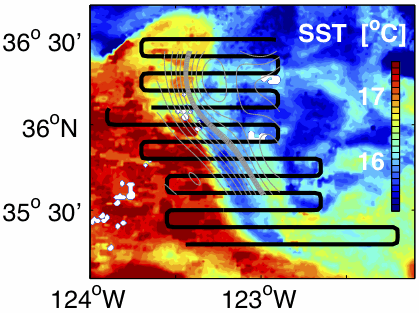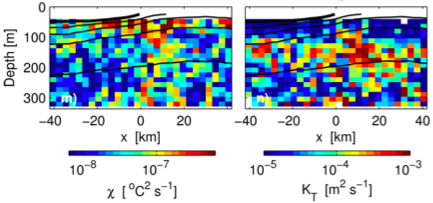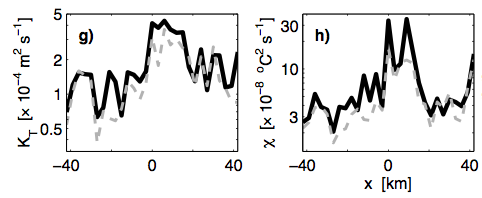ELEVATED MIXING AT A FRONT
The meso-, submeso-, and microscale structure of a front in the California Current was observed using a towed vehicle (SeaSoar) outfitted with microconductivity sensors. Thirteen >60-km cross-front sections from the surface to ∼350 m in depth were covered in 3.5 days.

A composite cross-front section shows elevated mixing on the dense side. The front is at x = 0 km. On the dense side (x = 0-20 km), water downwells and gradients are elevated: i.e., Rossby numbers, horizontal strain, spice gradients, and microscale thermal dissipation (chi). Thermal eddy diffusivity (KT) reaches 10−3 m2 s−1 and increases 3–10× from the anticyclonic to the cyclonic side. The spatial structure of KT resembles that of Rossby number and strain on the dense side. Black lines are isopycnals.

The depth mean of KT is about 10−4 m2 s−1 and also shows that turbulence is elevated from x = 0-20 km on the dense side of the front. Dashed grey lines exclude data from possibly doubly diffusive regions.

Frontogenesis, internal wave blocking by elevated vorticity, or internal wave trapping in regions of horizontal strain may produce shear and mixing, which suggests an energy cascade from the mesoscale via the submesoscale to the microscale.
Mean turbulent heat fluxes reach 20–30 W m−2 on the dense side. Nitrate fluxes are estimated as 0.1–0.3 mmol m−2 s−1. A deep biomass maximum is seen in chlorophyll fluorescence and beam transmission as a thin (3–6 km wide), long (∼100 km) alongfront streamer at a depth of ∼70 m. At the deep biomass maximum, time scales for mixing and nutrient fluxes are all roughly 0.3–3 days, which are similar to phytoplankton growth rates and the time scale for frontal evolution. Thick grey lines show x = 0 and 20 km at a depth of 50 m. Thin grey line shows cruise track and dots indicate the 3-km bins.

This research was funded by the Office of Naval Research through the Assessing the Effectiveness of Submesoscale Ocean Parameterizations Departmental Research Initiative.
